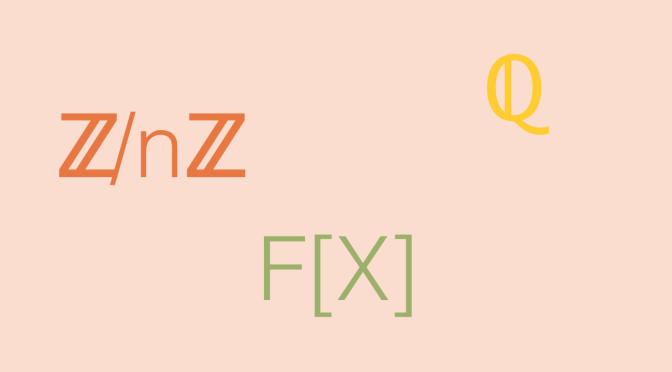Let’s start by recalling some background about modules.
Suppose that \(R\) is a ring and \(1_R\) is its multiplicative identity. A left \(R\)-module \(M\) consists of an abelian group \((M, +)\) and an operation \(R \times M \rightarrow M\) such that for all \(r, s \in R\) and \(x, y \in M\), we have:
- \(r \cdot (x+y)= r \cdot x + r \cdot y\) (\( \cdot\) is left-distributive over \(+\))
- \((r +s) \cdot x= r \cdot x + s \cdot x\) (\( \cdot\) is right-distributive over \(+\))
- \((rs) \cdot x= r \cdot (s \cdot x)\)
- \(1_R \cdot x= x \)
\(+\) is the symbol for addition in both \(R\) and \(M\).
If \(K\) is a field, \(M\) is \(K\)-vector space. It is well known that a vector space \(V\) is having a basis, i.e. a subset of linearly independent vectors that spans \(V\).
Unlike for a vector space, a module doesn’t always have a basis.
The module \(\mathbb{Z}/n\mathbb{Z}\) of integers modulo \(n\)
Consider an integer \(n \ge 2\) and the module \(M\) of the integers modulo \(n\) denoted \(\mathbb{Z}/n\mathbb{Z}\) over the ring of the integers \(\mathbb{Z}\). For all \(x \in M\) we have \(n \cdot x = 0\). So a subset of \(M\) containing a non-zero element is linearly dependent. Therefore every non empty subset of \(M\) is also linearly dependent and cannot be a basis. As the linear span of the empty subset of \(M\) is defined to be \(\{0\}\) (because by convention a linear combination of no vectors sums to \(0\)), \(M\) has no basis.
\(\mathbb{Z}/n\mathbb{Z}\) is having torsion. But there also exist torsion-free modules not having a basis as we prove in next paragraph. Let’s recall that a torsion-free module is a module over a ring such that \(0\) is the only element annihilated by a regular element (non zero-divisor) of the ring.
The module \(\mathbb{Q}\) of the rational numbers over the integers
\(\mathbb{Q}\) is a module over the ring of the integers \(\mathbb{Z}\). \(\mathbb{Q}\) is torsion-free. As for the previous example, the empty subset is not a basis because \(\mathbb{Q} \neq \{0\}\).
A subset with a single element does not span \(\mathbb{Q}\)
We take \(r = \frac{p}{q} \in \mathbb{Q}\) where \(p,q\) are integers. For any integer \(m \neq 0\), we have \(\vert mr \vert > \vert \frac{1}{2q} \vert\). So \(\frac{1}{2q} \notin \mbox{Span}(\{r\})\) and \(\{r\}\) cannot be a basis.
A subset with two elements or more is dependent
We take a subset \(S \subset \mathbb{Q}\) containing at least two elements \(r_1=\frac{p_1}{q_1},r_2=\frac{p_2}{q_2}\). As \((q_1 p_2) r_1- (q_2 p_1) r_2 = 0\), \(S\) is a dependent subset.
Finally, whatever is the cardinal of a subset \(S \subset \mathbb{Q}\), it cannot be a basis of \(\mathbb{Q}\) as a module over the integers.
The module \(F[X]\) over the ring \(F^\prime[X]\)
Let \(F[X]\) be the ring of polynomials over a field \(F\) and \(F^\prime[X]\) be the ring of all polynomials of \(F[X]\) that have coefficient of \(X\) equal to \(0\). Then \(F[X]\) is an \(F^\prime[X]\)-module. \(F[X]\) is finitely generated by the generating subset \(T=\{1,X\}\) as any polynomial \(P(X)=a + bX + X^2 Q(X) \in F[X]\) can be written \((a+X^2Q(X)) \cdot 1+ b \cdot X\). But \(T\) is not an independent subset as follows from the relation \(X^3 \cdot 1 – X^2 \cdot X=0\).
\(F[X]\) is also torsion-free because it is an integral domain.
Let suppose that a subset \(S \subset F[X]\) is a basis. \(S\) cannot have a single element \(P\) since if \(\deg(P)>0\), the constant polynomials cannot be generated whereas if \(\deg(P)=0\) that’s the polynomials having coefficient of \(X\) different than \(0\) that cannot be generated. But if \(S\) contains two distinct polynomials \(P_1, P_2\) then \(S\) is a dependent subset as \((X^2 P_2) \cdot P_1 – (X^2 P_1) \cdot P_2=0\).


2 thoughts on “A module without a basis”